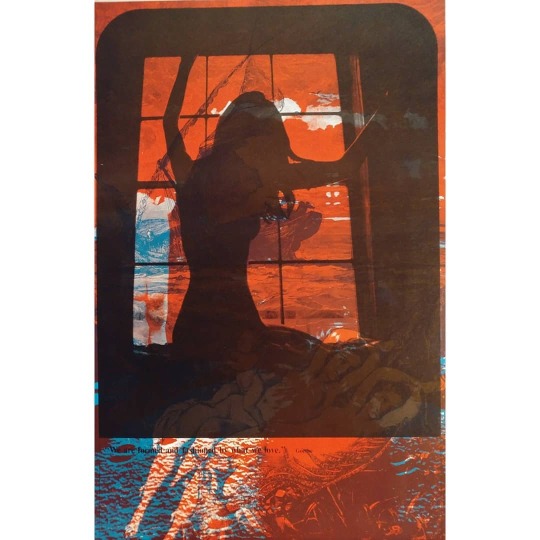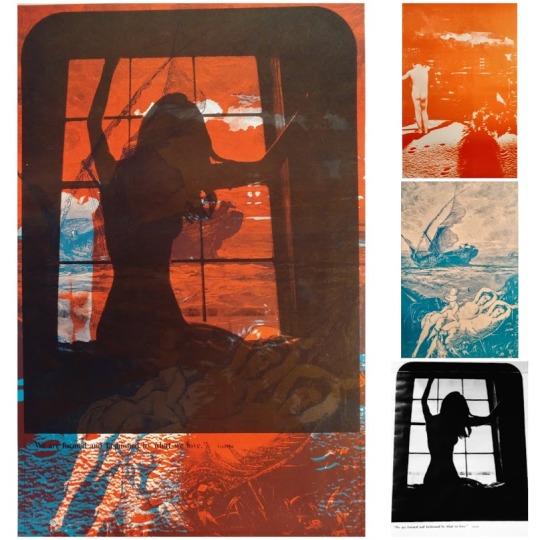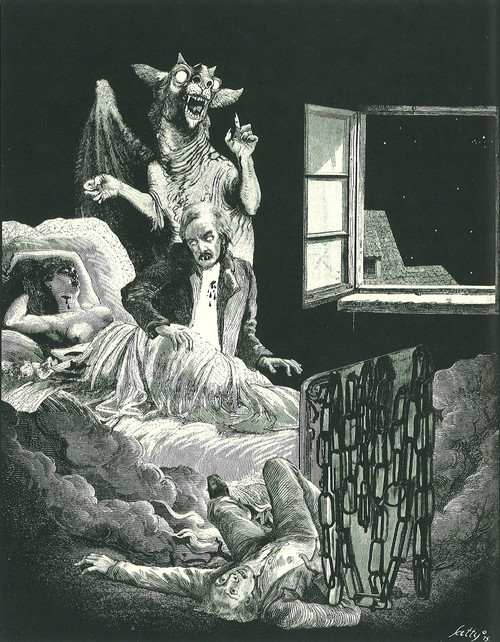#Wilfried Podriech
Explore tagged Tumblr posts
Text



Wilfried Podriech aka Sätty
The Annotated Dracula. 1975
#sätty#wilfried podriech#book illustrations#collage art#dark fantasy#gothic aesthetic#surrealism#german artist
35 notes
·
View notes
Text










Sätty (Wilfried Podriech).
44 notes
·
View notes
Photo


Original 1970 offset lithograph from artist Sätty printed over photo of Nude Woman In Window by Mike Powers, designed by Dale Smith above quote from Goethe: "We are formed and fashioned by what we love." Celestial Arts CA86 Orbit Graphic Arts, a poster printing company based out of San Francisco during the 1960s/1970s, distributed this overprinting by Sätty who was famous for creating mind-blowing and now highly collectible collages, having been exhibited at the MoMA, Boston Museum of Fine Arts, San Francisco Museum of Art and several other major museums listed below. If you look at the last photo, you'll see two of the base images (both available for purchase if interested) over which he would print layers of other illustrations. www.etsy.com/shop/BillsArchives One of the better-known poster artists when the psychedelic era was in full flower in the 60's, Wilfried (Wilfred) Podriech, also known as Sätty, was as much a part of the scene as Dr. Hip or the Grateful Dead. For a few years, his life had been one long summer of love. He staged huge parties where socialites and hippies mingled, in a subterranean basement of the pre-earthquake building where he lived on. He was schooled in architecture, engineering and design, and spent some time working in Brasilia before he settled in San Francisco in the early 60's. It was the threshold of the psychedelic era, and Sätty soon began making posters, developing an extraordinary collage technique that brought together both the technological and surreal sides of his background. Drawing from his enormous collection of 19th-century illustrations, and using his knowledge of overprinting, collage, overlays, paints and offset lithography, Sätty superimposed and juxtaposed images to create layered compositions of such wildness, density and subtle detail that they speak more tellingly than any static visual records of the time could do. His transformations of the original materials range from the discreet addition of a few whimsical oddities in the foreground of an etching, to the full-out hallucinations of an opium den or a ballroom swirling with romantic delirium. And the fact that these are all 19th-century images, radically revised by a 20th-century eye, gives one the eerie sense of shifting back and forth in time, space and perception. There's a startling sardonic humor in Sätty's visionary history, but there is love as well for the reckless, plunging voracity of those early days. EXHIBITIONS One Man Shows: • Moore Gallery, San Francisco; 1968. • Berkeley Gallery, San Francisco; 1970. • Goethe Center, San Francisco; 1971. Group Shows: • San Francisco Museum of Art; 1967. • Moore Gallery, "Second Joint Show", San Francisco; 1968. • Museum of New York City; 1969. • Boston Museum of Fine Arts; 1969. • Sun Gallery, San Francisco; 1969-1971 • National Museum of Art, Belgrade, Yugoslavia; 1970. • National Museum, Warsaw, Poland; 1970. • Gary Standiford Gallery, San Francisco; 1970-1971. • Richmond Art Center, California; 1971. • Museum of Modern Art, New York; 1971. • Arts and industry exhibition, San Francisco; 1971. • Dr. Reidar Wennesland Art Collection (public Exhibition), San Francisco; 1971. • Gallery: The Poster (with David singer), Los Angeles; 1972. • Kristiansand Art Association, Norway; 1972. • The Palace of the Legion of Honor, San Francisco; April-June 1975. GUEST LECTURES • The artist's studio, San Francisco; 1970. Lecture for members of the Society for the Encouragement for Contemporary Art concerning "Art and the Electronic Media". • Berkeley Gallery, San Francisco; 1971. Lecture about the artist' work for members of the San Francisco Museum of Art. • San Francisco Art Institute; 1971 and 1974. Two lectures in printmaking and one lecture for students at the artist's studio. • College of Arts and Crafts, Oakland; 1974. Lectures on "Photo and Printmaking" with slide show. • San Francisco State University, Art Department; 1974. "Imagination vs. Media" with slide show. • San Francisco Museum of Art; 1974. "Media and Poster Art" with slide show. • San Francisco State University, Literature Department; 1975. "Composition" with slide show. PUBLISHED ILLUSTRATIONS Washington Post (Book World- syndicated Sunday supplement) 1973-1975- nine illustrations. • Rolling Stone (26 issues) 1969-1975. • Berkeley Barb, 1969. • East Village Other, 1969. • Organ (7), 1970. • Oz Magazine, England (3 issues), 1971-1974. • Clear Creek (10), 1971-1972. • KPFA folio, 1971-1972. • Ramparts (4), 1972. • Communication Arts Magazine (2), 1972. • Sunday Paper (illustrated in collaboration with David Singer), 1972. • Equilibrium (5), 1973. • Video City- Radical software (2), 1973. • Living Daylights, Australia (2 illustrations from "Time Zone", 1974. • Village voice, 1975. COVER ART • Washington Post (book World syndicated Sunday supplement, 1973-1975: The Sovereign State of ITT, by Anthony Sampson. Gravity's Rainbow, by Thomas Pynchon. Through Russian Eyes, by Anatolii Gromyko. Richie, by Thomas Thompson. Before Civilization, by Colin Renfrew. The Clockwork Testament, by Anthony Burgess. • California Living, Los Angeles, 1969. Two color posters as part of cover. • The East Village Other, New York, 1969. • Berkeley Barb, Berkeley, 1969. Two covers • KPFA Folio, Berkeley 1972. • Publisher's Weekly, New York, April 1975. • The San Francisco Sunday Examiner And Chronicle, 1975. RECORD ALBUM COVERS • "GHANDARVA", Beaver and Kraus; Warner Bros., 1971. Five color cover with David Singer. • "The Occult", United Artists, 1973. A variety of interviews and music. Color cover and back plus 1 color and 12 black and white illustrations in booklet explaining the album. • "The Miraculous Hump Returns from the Moon", The Sopwith Camel, Warner Bros, 1973. • "Feel", George duke, MPS Records, 1974. Separate European release, MPS Records , 1975. • "The Aura Will Prevail", George duke, HPS Records, 1975. BOOKS • The Cosmic Bicycle: Straight Arrow Books, San Francisco, 1971. Limited hardbound edition, regular softbound edition. 160 9"x 12" pages. 79 black and white and 8 four color illustrations. Four color cover and back. • Time Zone: Straight Arrow Books, San Francisco, 1973. 9" x 12" softbound edition, 160 pages, 84 black and white illustrations. Three color cover and back. ISBN: 0879320281 0879320672 (pbk.) BOOK ILLUSTRATIONS AND COVERS • Biafra Good-bye, 1970 • Rolling Stone Book of Days, 1970-71 • One Eighty Five, 1973 • The Axis of Eros, 1973 • Madness Network News Reader, 1974 • Monsters, 1974 • The Index of Possibilities-Energy and Power, 1974 • The Rainbow Book, 1975 • The Annotated Dracula, 1975 • The Hashish Eater, 1975 • The Illustrated Edgar Allan Poe 1976
#Satty#Mike Powers#Dale Smith#Celestial Arts#Orbit Graphic Arts#Goethe#Psychedelic Posters#PsychedelicArt#lithograph#collage#Wilfried Podriech#Wilfred Podriech#Sätty#museum collection#museum collections
4 notes
·
View notes
Video
Wilfried Satty Podreich-from The Cosmic Bicycle (1971) by leiris202
#Wilfried Sätty Podriech#Satty#Wilfried Sätty#Wilfried Podriech#collage#time zone#cosmic bicycle#art#artist
3 notes
·
View notes
Photo

Underground - Sätty, Wilfried (das ist Wilfried Podriech) Stone Garden. Offset-Lithographie. Mill Valley, East Totem/Orbit Graphic Arts, um 1967. Blattgröße: 88 x 58,5 cm.
32 notes
·
View notes
Photo

Wilfried "Sätty" Podriech - The Annotated Dracula
404 notes
·
View notes
Photo


Wilfried Sätty “Man, myth et magic” en 1970
Wilfried Sätty (Wilfried Podriech) est né à Brême, en Allemagne, en 1939, au lendemain de la guerre, nous le retrouvons au Canada et ensuite à San Francisco où il s’associera aux artistes de la Beat Generation, puis au mouvement psychédélique. Ses visions prenaient les voies de l’illusionniste, comme s’il avait compris le premier que les hallucinations expressionnistes pouvaient se mélanger à l’Art Nouveau pour fabriquer un rêve proche du cauchemar, avec toujours le rêve plus fort que le cauchemar.
Wilfried Sätty (Wilfried Podriech) was born in Bremen, Germany, in 1939, in the aftermath of the war, we find him in Canada and then in San Francisco where he will associate with the Beat Generation artists and then with the psychedelic movement. His visions took the paths of the illusionist, as if he understood the first that expressionistic hallucinations could mix with the Art Nouveau to make a dream close to nightmare, with always the dream stronger than the nightmare.
235 notes
·
View notes
Photo

Wilfried "Sätty" Podriech - The Annotated Dracula
30 notes
·
View notes
Photo

“Satty” Wilfried Podriech (Germany, 1939 - 1982).
76 notes
·
View notes
Photo

Wilfred ‘Sätty’ Podriech
Collage engraving from The Cosmic Bicycle, 1971
#wilfried sätty#illustration#collage art#book engraving#art#german art#surrealism#wilfried podriech#wilfred satty podriech
17 notes
·
View notes
Photo

0 notes
Video
from The Cosmic Bicycle (1971) by leiris202
#Wilfried Sätty Podriech#Satty#Wilfried Sätty#Wilfried Podriech#collage#time zone#cosmic bicycle#art#artist
13 notes
·
View notes
Photo

Nature Boy - Sätty Wilfried Podriech
10 notes
·
View notes
Photo

Wilfried "Sätty" Podriech - The Annotated Dracula
64 notes
·
View notes
Photo





Taken from The Cosmic Bicycle by Wilfried "Sätty" Podriech, 1971
118 notes
·
View notes
Photo

Wilfried "Sätty" Podriech - The Annotated Dracula
13 notes
·
View notes